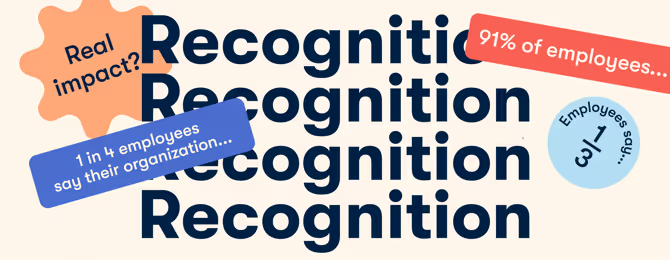Why employee recognition is so important for remote teams

Discover Workleap Officevibe's benchmark report on 12 key employee engagement metrics

When was the last time you received recognition at work? How about the last time you gave a shoutout to someone else?
If it was a while ago, you’re not alone: Only a third of professionals get regular praise. But companies that focus on employee recognition reap incredible benefits. They have better retention rates, and their productive, highly motivated workforce drives better results.
That’s why learning how to recognize employees well is a must. Here’s how to do it right.
What’s employee recognition?
Employee recognition means giving workers positive feedback for a job well done. It can be peer-to-peer or come from a manager or leader, recognizing things like:
- Achievements: Companies can highlight when an employee hits an important milestone, like successfully finishing a project. Many also celebrate anniversaries and promotions.
- Great conduct: Leaders should praise employees for excellent behavior, like meeting deadlines or giving extra support to colleagues.
- Going above and beyond: Peers and managers can shout out teammates for excelling at tasks.
Why remote employee recognition is important
When people do great work but don’t get external praise, they may lose motivation and start to question their work. This can be even more intense for remote employees, who don’t often get face time with their managers and peers.
Key benefits of employee recognition
Taking a proactive approach to recognition can:
- Drive excellence: When you praise workers for strong work, they know they’re on the right track.
- Increase employee engagement: Workers who feel valued know they play an essential role in an organization, nurturing a deep connection with work and driving employee engagement.
- Build remote relationships: Unless you intentionally create opportunities for connection, remote employees don’t get as much quality time with coworkers and leadership. Foster stronger relationships by regularly recognizing these workers. And go public with the appreciation, shouting out folks on shared platforms where everyone can celebrate their wins.
- Boost retention: Employees who feel good about themselves and their job are less likely to leave. You can drive job satisfaction by reinforcing your workers’ value at every turn.
- Catch issues before they start: As you look for ways to recognize employees, you’ll want to review performance data. When this information turns up issues, you can jump in to provide constructive criticism.
Types of employee recognition and how they apply to remote work
Effective employee recognition comes in different shapes and sizes, from a quick word of praise to organized feedback. Here are a few styles of employee recognition and how to use them with remote workers.
Formal recognition
Formal recognition is the umbrella term for planned acts of appreciation. A company might have an employee of the month award or achievement-based perks. Keep these rituals alive at remote companies by virtually celebrating an employee.
Informal recognition
Informal recognition refers to spontaneous feedback, like an in-the-moment kudos or thank-you note. If a remote employee gets a task done before a deadline, send them a message to keep up the great work. Or congratulate a team member on their progress at your morning virtual standup meeting.
Peer-to-peer recognition
Encourage peers to shout one another out to foster connection among your virtual workforce. This is also a good way to learn more about employee contributions that you don’t usually see. With Workleap Officevibe’s Good Vibes feature, employees can send peer-to-peer shoutouts privately or publicly, driving a culture of recognition.
Milestone celebrations
Milestone celebrations mark important dates in a person's life and career, like recognizing folks on their birthdays or work anniversaries. Gather the team for a virtual party and have everyone come prepared with their favorite snack.
Monetary recognition
Monetary recognition refers to bonuses and other economic perks for stellar work. An employee might earn extra on their next paycheck after meeting a performance goal. Spontaneously celebrating a remote worker’s efforts with a surprise gift card is another great option.
Promotional recognition
Promotional recognition is when an employee earns a promotion for their hard work. When possible, acknowledge employees' skills and leadership potential by advancing them into a manager role or boosting their pay.
Key elements of a successful remote employee recognition program
Remote companies follow many of the same employee recognition best practices as in-person organizations. But these plans can be tougher to implement with a geographically dispersed team. Here’s how you can drive recognition in the workplace, even if your workers are hybrid or fully remote.
Announce goals and recognizable achievements
Make employees’ performance goals clear and announce any perks associated with achieving them. If the company has programs like employee-of-the-month, make sure all new hires know how to earn the title.
Be consistent
Frequent recognition helps reassure employees that they’re on the right track. Even a virtual pat on the back works wonders. But make sure you plan formal feedback ahead of time, too. Announce top performers monthly and schedule performance reviews to celebrate wins and plan new goals.
Be precise
Feedback should be precise, whether it’s formal or informal. For example, performance reviews should contain data-based insights and targets so the employee has a clear idea of what they’re doing well and why it deserves celebration. They’ll also know where they need to improve and how. Be just as direct in informal feedback: Let the individual know what specific things they’ve done well instead of just saying they’re doing a great job.
Foster inclusive recognition practices
Everyone has different strengths, and all employees deserve recognition at some point. Build an inclusive recognition plan that rewards various role-specific accomplishments. One person might have an excellent customer service mindset, and another might have completed a challenging report on time.
Be transparent
Put a clear, transparent employee recognition program in place so praise never feels arbitrary or unfair. When everyone understands how recognition is earned and the same metrics are applied across the board, it builds trust and reinforces inclusivity. Employees can see that every team member is considered equally and celebrated for their contributions.
5 remote employee recognition ideas
If you manage a remote team, brainstorm employee recognition ideas that fit the virtual landscape. Here are five that combine fun and meaningful feedback.
1. Come together
Some virtual employees don’t know their peers very well. Foster connection with optional weekly events and chat platforms people can use for fun. People who form bonds with their peers want to see them succeed, which makes individual accomplishments feel more like a team win.
2. Foster team spirit
Host bonding activities that drive recognition, like a virtual “ideathon” where employees work together to share ideas for new products or projects. This also allows you to recognize the minds behind the winning proposal.
3. Make recognition part of daily life
Add appreciation moments to your regular meetings. Block off time at the end of your virtual huddles to give a shoutout to teams for a job well done. Or open up the floor to your employees and give them the chance to praise their colleagues.
4. Have remote rewards
Virtual employees can feel like they miss out on in-person perks, like break room donuts or socializing opportunities. Reward your remote teams with similar benefits. You might allow hardworking employees to order takeout on the company tab or surprise them with a gift card.
5. Use recognition platforms
Tech is often the glue that binds remote teams, so use it for employee recognition. Tools like Workleap Officevibe help teams bond and build connections. Workers can send each other personalized cards for milestone moments or everyday shoutouts for small wins.
Examples of impactful remote employee recognition
Here are a few remote employee recognition ideas from organizations that value these initiatives:
- Zappos: This footwear company offers peer-driven financial incentives. Colleagues can award each other a $50 bonus for a job well done.
- Southwest Airlines: Employees at this company can earn Southwest Airlines Gratitude points (SWAG) to spend on gift cards, products, and experiences. Teammates can also nominate one another for awards that go along with the points.
- DHL: Because its team is so spread out, DHL finds creative ways to recognize employees. One example is a worker appreciation week full of activities and perks. This is a great reminder that strong employee recognition plans include get-togethers that help remote teams bond.
Show employee appreciation with Workleap
Workleap Officevibe makes it easy to create recognition incentives that really resonate. Use pulse surveys to track how engaged and appreciated employees feel, and spark positivity with Good Vibes — quick, meaningful notes of recognition that anyone can send. Over time, these gestures help build a culture where appreciation is part of the everyday flow, not just a quarterly event.
Try Workleap Officevibe for free today to start creating a culture of appreciation that lasts.
Give HR and managers the clarity, confidence, and connection to lead better every day.


%20(1).avif)


.avif)
.avif)







